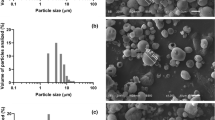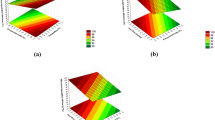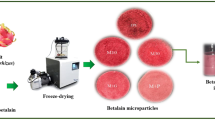Abstract
Different encapsulating agents from agroindustrial waste were tested to encapsulate betalains from red pitaya for use as natural pigments. Mucilage, extracted from the fruit peel, and gelatin from nutraceutical capsules were tested in combination with maltodextrin, and the microencapsulation was done by the spray drying method. The powders were characterized by their physicochemical properties, encapsulation yield and efficiency, morphology, betalain content, and glass transition temperature. The storage stability and the application in a food model system were also evaluated. The capsules presented low moisture and water activity, which is adequate for their safety and application. The encapsulation yields (16–25%) obtained were due to the low solid contents presented, and the combination of both wall materials increased the betalains retention by 7% in relation to liquid extract. Results for efficiency of encapsulation (above 90%) and glass transition temperature (around 85 °C) were highly satisfactory, indicating that the compounds remain well protected inside the capsule and a good storage stability of the powders. The morphology image and the results of particle size prove the obtained microcapsules, and the powder with mucilage was highlighted in relation to its stability under the studied storage conditions, retaining more than 80% of the pigment in 50 days. The microcapsules when added in yogurts corroborate the stability results and indicate the great potential of mucilage as an encapsulating agent for the food industry.





Similar content being viewed by others
References
AOAC (Association of Official Analytical Chemists) (2005). Official Methods of Analysis of the Association of Analytical Chemists International, 18th ed. Gathersburg, MD U.S.A Official methods, 2005.08.
Augustin, M. A., & Hemar, Y. (2009). Nano- and micro-structured assemblies for encapsulation of food ingredients. Chemical Society Reviews, 38(4), 902–912. https://doi.org/10.1039/B801739P.
Bakar, J., Ee, S. C., Muhammad, K., Hashim, D. M., & Adzahan, N. (2013). Spray-drying optimization for red pitaya peel (Hylocereus polyrhizus). Food and Bioprocess Technology, 6(5), 1332–1342. https://doi.org/10.1007/s11947-012-0842-5.
Bazaria, B., & Kumar, P. (2016). Effect of whey protein concentrate as drying aid and drying parameters on physicochemical and functional properties of spray dried beetroot juice concentrate. Food Bioscience, 14, 21–27. https://doi.org/10.1016/j.fbio.2015.11.002.
Bazaria, B., & Kumar, P. (2017a). Comparative analysis of bio-polymers addition on structural and physical properties of spray dried beetroot juice concentrate. Journal of Food Processing and Preservation, 41(6), 1–8. https://doi.org/10.1111/jfpp.13232.
Bazaria, B., & Kumar, P. (2017b). Effect of dextrose equivalency of maltodextrin together with Arabic gum on properties of encapsulated beetroot juice. Journal of Food Measurement and Characterization, 11(1), 156–163. https://doi.org/10.1007/s11694-016-9382-4.
Cai, Y. Z., & Corke, H. (2000). Production and properties of spray-dried Amaranthus betacyanin pigments. Journal of Food Science, 65(3600), 1248–1252.
Castellar, R., Obónn, J. M., Alacid, M., & Fernández-López, J. A. (2003). Color properties and stability of betacyanins from Opuntia fruits. Journal of Agricultural and Food Chemistry, 51(9), 2772–2776. https://doi.org/10.1021/jf021045h.
Castro-Enríquez, D. D., Montaño-Leyva, B., Del Toro-Sánchez, C. L., Juaréz-Onofre, J. E., Carvajal-Millan, E., Burruel-Ibarra, S. E., et al. (2020). Stabilization of betalains by encapsulation—a review. Journal of Food Science and Technology, 57(5), 1587–1600. https://doi.org/10.1007/s13197-019-04120-x.
Ceja-Medina, L. I., Ortiz-Basurto, R. I., Medina-Torres, L., Calderas, F., Bernad-Bernad, M. J., González-Laredo, R. F., et al. (2020). Microencapsulation of Lactobacillus plantarum by spray drying with mixtures of Aloe vera mucilage and agave fructans as wall materials. Journal of Food Process Engineering, (April), 1–12. https://doi.org/10.1111/jfpe.13436
Celli, G. B., & Brooks, M. S. L. (2017). Impact of extraction and processing conditions on betalains and comparison of properties with anthocyanins — A current review. Food Research International, 100(Pt 3), 501–509. https://doi.org/10.1016/j.foodres.2016.08.034.
Choo, K. Y., Kho, C., Ong, Y. Y., Thoo, Y. Y., Lim, R. L. H., Tan, C. P., & Ho, C. W. (2018). Studies on the storage stability of fermented red dragon fruit (Hylocereus polyrhizus) drink. Food Science and Biotechnology, 1–7. https://doi.org/10.1007/s10068-018-0367-4
Condurache, N. N., Aprodu, I., Crăciunescu, O., Tatia, R., Horincar, G., Barbu, V., Enachi, E., Râpeanu, G., Bahrim, G. E., Oancea, A., & Stănciuc, N. (2019). Probing the functionality of bioactives from eggplant peel extracts through extraction and microencapsulation in different polymers and whey protein hydrolysates. Food and Bioprocess Technology, 12(8), 1316–1329. https://doi.org/10.1007/s11947-019-02302-1.
Davidov-Pardo, G., Arozarena, I., & Marín-Arroyo, M. R. (2013). Optimization of a wall material formulation to microencapsulate a grape seed extract using a mixture design of experiments. Food and Bioprocess Technology, 6(4), 941–951. https://doi.org/10.1007/s11947-012-0848-z.
de Moura, S. C. S. R., Schettini, G. N., Garcia, A. O., Gallina, D. A., Alvim, I. D., & Hubinger, M. D. (2019). Stability of hibiscus extract encapsulated by ionic gelation incorporated in yogurt. Food and Bioprocess Technology, 12(9), 1500–1515. https://doi.org/10.1007/s11947-019-02308-9.
Delia, S. C., Chávez, G. M., León-Martínez Frank, M., Araceli, S. G. P., Irais, A. L., & Franco, A. A. (2019). Spray drying microencapsulation of betalain rich extracts from Escontria chiotilla and Stenocereus queretaroensis fruits using cactus mucilage. Food Chemistry, 272(April 2018), 715–722. https://doi.org/10.1016/j.foodchem.2018.08.069.
Dick, M., Dal Magro, L., Rodrigues, R. C., Rios, A. d. O., & Flôres, S. H. (2019). Valorization of Opuntia monacantha (Willd.) Haw. cladodes to obtain a mucilage with hydrocolloid features: Physicochemical and functional performance. International Journal of Biological Macromolecules, 123, 900–909. https://doi.org/10.1016/j.ijbiomac.2018.11.126.
Ding, Z., Tao, T., Wang, X., Prakash, S., Zhao, Y., Han, J., & Wang, Z. (2020). Influences of different carbohydrates as wall material on powder characteristics, encapsulation efficiency, stability and degradation kinetics of microencapsulated lutein by spray drying. International Journal of Food Science and Technology, 55(7), 2872–2882. https://doi.org/10.1111/ijfs.14544.
Downham, A., & Collins, P. (2000). Colouring our foods in the last and next millennium. International Journal of Food Science and Technology, 35(1), 5–22. https://doi.org/10.1046/j.1365-2621.2000.00373.x.
Espino-Díaz, M., De Jesús Ornelas-Paz, J., Martínez-Téllez, M. A., Santillán, C., Barbosa-Cánovas, G. V., Zamudio-Flores, P. B., & Olivas, G. I. (2010). Development and characterization of edible films based on mucilage of Opuntia ficus-indica (L.). Journal of Food Science, 75(6), 347–352. https://doi.org/10.1111/j.1750-3841.2010.01661.x.
Etxabide, A., Uranga, J., Guerrero, P., & de la Caba, K. (2017). Development of active gelatin films by means of valorisation of food processing waste: a review. Food Hydrocolloids, 68, 192–198. https://doi.org/10.1016/j.foodhyd.2016.08.021.
Fang, Z., & Bhandari, B. (2010). Encapsulation of polyphenols - a review. Trends in Food Science and Technology, 21(10), 510–523. https://doi.org/10.1016/j.tifs.2010.08.003.
Fathordoobady, F., Mirhosseini, H., Selamat, J., Yazid, M., & Manap, A. (2016). Effect of solvent type and ratio on betacyanins and antioxidant activity of extracts from Hylocereus polyrhizus flesh and peel by supercritical fluid extraction and solvent extraction. Food Chemistry, 202, 70–80. https://doi.org/10.1016/j.foodchem.2016.01.121.
García-Lucas, K. A., Méndez-Lagunas, L. L., Rodríguez-Ramírez, J., Campanella, O. H., Patel, B. K., & Barriada-Bernal, L. G. (2016). Physical properties of spray dryed Stenocereus griseus pitaya juice powder. Journal of Food Process Engineering, (August), 1–9. https://doi.org/10.1111/jfpe.12470
Gengatharan, A., Dykes, G. A., & Choo, W.-S. (2017). The effect of pH treatment and refrigerated storage on natural colourant preparations (betacyanins) from red pitahaya and their potential application in yoghurt. LWT - Food Science and Technology, 80, 437–445. https://doi.org/10.1016/j.lwt.2017.03.014.
Gonçalves, L. C. P., Di Genova, B. M., Dörr, F. A., Pinto, E., & Bastos, E. L. (2013). Effect of dielectric microwave heating on the color and antiradical capacity of betanin. Journal of Food Engineering, 118(1), 49–55. https://doi.org/10.1016/j.jfoodeng.2013.03.022.
Güneşer, O. (2015). Pigment and colour stability of beetroot betalains in cow milk during thermal running head : Thermal stability of beetroot betalains in milk. Food Chemistry, (September). https://doi.org/10.1016/j.foodchem.2015.09.033
Gutiérrez, M. C., Utrilla-Coello, R. G., & Soto-Castro, D. (2018). Effect of Opuntia ficus-indica mucilage in the ecological extraction, drying, and storage of eggplant anthocyanins. Journal of Food Processing and Preservation, 42(2), 1–8. https://doi.org/10.1111/jfpp.13439.
Handayani, M. N., Khoerunnisa, I., Cakrawati, D., & Sulastri, A. (2018). Microencapsulation of dragon fruit (Hylocereus polyrhizus) peel extract using maltodextrin. IOP Conference Series: Materials Science and Engineering, 288(1), 1–8. https://doi.org/10.1088/1757-899X/288/1/012099.
Iahnke, A. O.e S., Costa, T. M. H., Rios, A. d. O., & Flôres, S. H. (2015). Residues of minimally processed carrot and gelatin capsules: Potential materials for packaging films. Industrial Crops and Products, 76, 1071–1078. https://doi.org/10.1016/j.indcrop.2015.08.025.
Jamilah, B., Shu, C. E., Kharidah, M., Dzulkifly, M. A., & Noranizan, A. (2011). Physico-chemical characteristics of red pitaya (Hylocereus polyrhizus) peel. International Food Research Journal, 18(1), 279–286. https://doi.org/10.1163/156856103321645176.
Janiszewska-Turak, E., Dellarosa, N., Tylewicz, U., Laghi, L., Romani, S., Dalla Rosa, M., & Witrowa-Rajchert, D. (2017). The influence of carrier material on some physical and structural properties of carrot juice microcapsules. Food Chemistry, 236, 134–141. https://doi.org/10.1016/j.foodchem.2017.03.134.
Kanner, J., Harel, S., & Granit, R. (2001). Betalains - A new class of dietary cationized antioxidants. Journal of Agricultural and Food Chemistry, 49(11), 5178–5185. https://doi.org/10.1021/jf010456f.
Kanwate, B. W., Ballari, R. V., & Kudre, T. G. (2019). Influence of spray-drying, freeze-drying and vacuum-drying on physicochemical and functional properties of gelatin from Labeo rohita swim bladder. International Journal of Biological Macromolecules, 121, 135–141. https://doi.org/10.1016/j.ijbiomac.2018.10.015.
Lee, K. H., Wu, T. Y., & Siow, L. F. (2013). Spray drying of red (Hylocereus polyrhizus) and white (Hylocereus undatus) dragon fruit juices: Physicochemical and antioxidant properties of the powder. International Journal of Food Science and Technology, 48(11), 2391–2399. https://doi.org/10.1111/ijfs.12230.
Leong, H. Y., Ooi, C. W., Law, C. L., Julkifle, A. L., Pan, G. T., & Show, P. L. (2018). Investigation of betacyanins stability from peel and flesh of red-purple pitaya with food additives supplementation and pH treatments. Lwt, 98(September), 546–558. https://doi.org/10.1016/j.lwt.2018.09.021.
Medina-Torres, L., Núñez-Ramírez, D. M., Calderas, F., González-Laredo, R. F., Minjares-Fuentes, R., Valadez-García, M. A., Bernad-Bernad, M. J., & Manero, O. (2019). Microencapsulation of gallic acid by spray drying with aloe vera mucilage (Aloe barbadensis miller) as wall material. Industrial Crops and Products, 138(June), 111461. https://doi.org/10.1016/j.indcrop.2019.06.024.
Méndez-Lagunas, L., García-Lucas, K., Rodríguez-Ramírez, J., Campanella, O. H., Patel, B. K., & Sandoval-Torres, S. (2013). Physical properties of spray dried pitaya. Researchgate.Net, (February 2015), 2–4.
Nambiar, R. B., Sellamuthu, P. S., & Perumal, A. B. (2017). Microencapsulation of tender coconut water by spray drying: effect of moringa oleifera gum, maltodextrin concentrations, and inlet temperature on powder qualities. Food and Bioprocess Technology, 10(9), 1668–1684. https://doi.org/10.1007/s11947-017-1934-z.
Obón, J. M., Castellar, M. R., Alacid, M., & Fernández-López, J. A. (2009). Production of a red–purple food colorant from Opuntia stricta fruits by spray drying and its application in food model systems. Journal of Food Engineering, 90(4), 471–479. https://doi.org/10.1016/j.jfoodeng.2008.07.013.
Otálora, M. C., Carriazo, J. G., Iturriaga, L., Nazareno, M. A., & Osorio, C. (2015). Microencapsulation of betalains obtained from cactus fruit (Opuntia ficus-indica) by spray drying using cactus cladode mucilage and maltodextrin as encapsulating agents. Food Chemistry, 187, 174–181. https://doi.org/10.1016/j.foodchem.2015.04.090.
Pedreño, M. A., & Escribano, J. (2001). Correlation between antiradical activity and stability of betanine from Beta vulgaris L roots under different pH, temperature and light conditions. Journal of the Science of Food and Agriculture, 81(7), 627–631. https://doi.org/10.1002/jsfa.851.
Ribeiro, A. M., Estevinho, B. N., & Rocha, F. (2019). Spray drying encapsulation of elderberry extract and evaluating the release and stability of phenolic compounds in encapsulated powders. Food and Bioprocess Technology, 12(8), 1381–1394. https://doi.org/10.1007/s11947-019-02304-z.
Rubio, F. T. V., Windson Isidoro Haminiuk, C., Martelli-Tosi, M., Palazzolli da Silva, M., Yasuo Figueiredo Makimori, G., & Sílvia Favaro-Trindade, C. (2020). Utilization of grape pomaces and brewery waste Saccharomyces cerevisiae for the production of bio-based microencapsulated pigments. Food Research International, 136(April), 109470. https://doi.org/10.1016/j.foodres.2020.109470.
Ruiz-Gutiérrez, M. G., Amaya-Guerra, C. A., Quintero-Ramos, A., de Jesús Ruiz-Anchondo, T., Gutiírrez-Uribe, J. A., Baez-González, J. G., et al. (2014). Effect of soluble fiber on the physicochemical properties of cactus pear (Opuntia ficus indica) encapsulated using spray drying. Food Science and Biotechnology, 23(3),755–763. https://doi.org/10.1007/s10068-014-0102-8.
Sandate-Flores, L., Rodríguez-Rodríguez, J., Calvo-Segura, S., Mayorga-Martínez, A., Parra-Saldívar, R., Chuck-Hernández, C. (2016). Evaluation of different methods for betanin quantification in pitaya (Stenocereus spp.). Agro Food Industry Hi-Tech, 27(1), 20–24.
Shaaruddin, S., Ghazali, H. M., Hamed Mirhosseini, S., & Muhammad, K. (2017). Stability of betanin in pitaya powder and confection as affected by resistant maltodextrin. LWT - Food Science and Technology, 84, 129–134. https://doi.org/10.1016/j.lwt.2017.05.031.
Sharif, N., Khoshnoudi-Nia, S., & Jafari, S. M. (2020). Nano/microencapsulation of anthocyanins; a systematic review and meta-analysis. Food Research International, 132(October 2019), 109077. https://doi.org/10.1016/j.foodres.2020.109077.
Sinthusamran, S., Benjakul, S., & Kishimura, H. (2015). Molecular characteristics and properties of gelatin from skin of seabass with different sizes. International Journal of Biological Macromolecules, 73(1), 146–153. https://doi.org/10.1016/j.ijbiomac.2014.11.024.
Stintzing, F. C., Schieber, A., & Carle, R. (2002). Betacyanins in fruits from red-purple pitaya, Hylocereus polyrhizus (Weber) Britton & Rose. Food Chemistry, 77(1), 101–106. https://doi.org/10.1016/S0308-8146(01)00374-0.
Stoll, L., Costa, T. M. H., Jablonski, A., Flôres, S. H., & de Oliveira Rios, A. (2016). Microencapsulation of anthocyanins with different wall materials and its application in active biodegradable films. Food and Bioprocess Technology, 9(1), 172–181. https://doi.org/10.1007/s11947-015-1610-0.
Tang, C. S., & Norziah, M. H. (2007). Stability of betacyanin pigments from red purple pitaya fruit (Hylocereus polyrhizus) : influence of pH, temperature, metal ions and ascorbic acid. Indian Journal of Chemistry, 7(3), 327–331. https://doi.org/10.14499/IJC-V7I3P327-331.
Thanatcha, R., & Pranee, A. (2007). Extraction and characterization of mucilage in Opuntia spp. Journal of Arid Environments J, 68(4), 534–545. https://doi.org/10.1016/j.jaridenv.2006.08.001.
Troya, D., Tupuna-Yerovi, D. S., & Ruales, J. (2018). Effects of wall materials and operating parameters on physicochemical properties, process efficiency, and total carotenoid content of microencapsulated banana passionfruit pulp (Passiflora tripartita var. mollissima) by spray-drying. Food and Bioprocess Technology, 11(10), 1828–1839. https://doi.org/10.1007/s11947-018-2143-0.
Tsai, P. J., Sheu, C. H., Wu, P. H., & Sun, Y. F. (2010). Thermal and pH stability of betacyanin pigment of djulis (Chenopodium formosanum) in Taiwan and their relation to antioxidant activity. Journal of Agricultural and Food Chemistry, 58(2), 1020–1025. https://doi.org/10.1021/jf9032766.
Tze, N. L., Han, C. P., Yusof, Y. A., Ling, C. N., Talib, R. A., Taip, F. S., & Aziz, M. G. (2012). Physicochemical and nutritional properties of spray-dried pitaya fruit powder as natural colorant. Food Science and Biotechnology, 21(3), 675–682. https://doi.org/10.1007/s10068-012-0088-z.
Utpott, M., Ramos de Araujo, R., Galarza Vargas, C., Nunes Paiva, A. R., Tischer, B., de Oliveira Rios, A., & Hickmann Flôres, S. (2020). Characterization and application of red pitaya (Hylocereus polyrhizus) peel powder as a fat replacer in ice cream. Journal of Food Processing and Preservation, 44(5), 1–10. https://doi.org/10.1111/jfpp.14420.
Vargas-Campos, L., Valle-Guadarrama, S., Martínez-Bustos, F., Salinas-Moreno, Y., Lobato-Calleros, C., & Calvo-López, A. D. (2018). Encapsulation and pigmenting potential of betalains of pitaya (Stenocereus pruinosus) fruit. Journal of Food Science and Technology, 55(7), 2436–2445. https://doi.org/10.1007/s13197-018-3161-7.
Vergara, C., Saavedra, J., Sáenz, C., García, P., & Robert, P. (2014). Microencapsulation of pulp and ultrafiltered cactus pear (Opuntia ficus-indica) extracts and betanin stability during storage. Food Chemistry, 157, 246–251. https://doi.org/10.1016/j.foodchem.2014.02.037.
Wang, Y., Ye, H., Zhou, C., Lv, F., Bie, X., & Lu, Z. (2012). Study on the spray-drying encapsulation of lutein in the porous starch and gelatin mixture. European Food Research and Technology, 234(1), 157–163. https://doi.org/10.1007/s00217-011-1630-6.
Author information
Authors and Affiliations
Corresponding authors
Additional information
Publisher’s Note
Springer Nature remains neutral with regard to jurisdictional claims in published maps and institutional affiliations.
Rights and permissions
About this article
Cite this article
Utpott, M., Assis, R.Q., Pagno, C.H. et al. Evaluation of the Use of Industrial Wastes on the Encapsulation of Betalains Extracted from Red Pitaya Pulp (Hylocereus polyrhizus) by Spray Drying: Powder Stability and Application. Food Bioprocess Technol 13, 1940–1953 (2020). https://doi.org/10.1007/s11947-020-02529-3
Received:
Accepted:
Published:
Issue Date:
DOI: https://doi.org/10.1007/s11947-020-02529-3




